





A member of Sts. Borys and Hlib Council 17740 in Fastiv, Ukraine, holds a candle during a visit to the Church of the Intercession of the Most Holy Theotokos in Fastiv. The vulnerable wooden church was recently laser-scanned with support from the Ukraine Solidarity Fund (see page 20).
3 For the greater glory of God
Knights are called to pray and work for the unity that Christ wills for the Church and our families.
By Supreme Knight Patrick E. Kelly4 Learning the faith, living the faith
By his death and resurrection, in the power of the Holy Spirit, the Lord seeks to heal and re-create us, body and soul.
By Supreme Chaplain Archbishop William E. Lori6 Building the Domestic Church
A new series on family life, leadership and financial stewardship
26 Knights in Action
Reports from councils and assemblies, representing Faith in Action
A cause for canonization has opened for Michelle Duppong, a North Dakota farmgirl and FOCUS missionary from a Knights of Columbus family.
By Patti Armstrong13
16 8
An interview with FOCUS founder Curtis Martin about the indispensable role of fathers and our universal mission to bring others to Christ.
The three Catholic priests on the doomed ship heroically brought comfort and absolution to its passengers until the end.
By K.V. Turley20 24
With Order support, conservation experts are creating digital scans of Ukraine’s churches to protect the country’s cultural heritage.
By Karolina ŚwiderAs the Church unites in Alleluias every Easter, we invite Jesus to pierce the darkness with joy and hope.
By Amy Welborn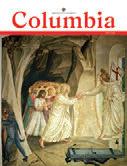
Christ is depicted liberating the righteous from hell on Holy Saturday in a 15th-century fresco by Fra Angelico.
Membership in the Knights of Columbus is open to men 18 years of age or older who are practical (that is, practicing) Catholics in union with the Holy See. This means that an applicant or member accepts the teaching authority of the Catholic Church on matters of faith and morals, aspires to live in accord with the precepts of the Catholic Church, and is in good standing in the Catholic Church.
kofc.org/join
Copyright
BENJAMIN FRANKLIN famously wrote in a 1789 letter, “In this world nothing can be said to be certain, except death and taxes.” This pairing of death and taxes is often repeated with tongue in cheek, yet it also relies on a stark reality: As much as we would like to avoid it, there is no escaping death. Popular author and philosopher Peter Kreeft, echoing an insight of St. Augustine, quipped that life itself is a terminal disease: “Life is always fatal. No one gets out of it alive.”
Even so, as many people put off doing their taxes, still more avoid thinking about death. While it may be acknowledged, and even sensationalized, in the abstract — consider the violent deaths in modern video games and movies — facing one’s own death is something else entirely. In Leo Tolstoy’s novella The Death of Ivan Ilyich, the title character considers the universal fact of mortality, which “had seemed to him all his life true only in its application to [others], but never to himself.” He thinks, “For me, that is another thing, and it cannot be that I must take my turn to die. That would be too horrible.”
In the mid-20th century, philosopher Paul Tillich associated anxiety of death with “anxiety of meaninglessness” and observed that in the modern world, “The reality of death is excluded from daily life to the highest possible degree.” Nearly 75 years later, instruments of distraction are rarely more than an arm’s length away. Technology will never succeed in overcoming death, try as it might, but it has managed to satiate the modern appetite for diversion.
By contrast, Knights of Columbus are presented with a different approach to life and
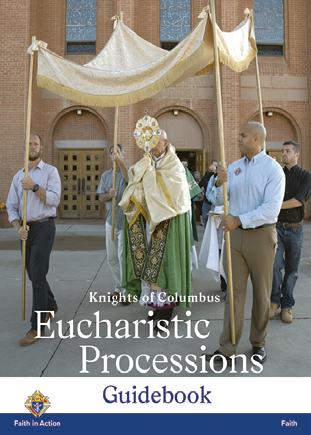
death during the exemplification of charity, unity and fraternity. “The perpetual watchword of our Order,” we are told, is “Tempus fugit. Memento mori,” which means “Time flies. Remember death” — or, more literally, “Time flies. Remember you must die.” This exhortation reminds us of the brevity of this life, which, from a Christian perspective, takes on eternal significance. St. James thus warns against a short-sightedness that seeks worldly comforts and ignores death: “You are a puff of smoke that appears briefly and then disappears. Instead you should say, ‘If the Lord wills it, we shall live to do this or that’” (Jas 4:14-15).
The specters of death and meaninglessness might indeed be objects of fear or avoidance were it not for the hope that we have in Jesus Christ. At the center of our faith stands the paschal mystery, which we celebrate this Easter season. The Catechism of the Catholic Church notes that it has two aspects: “By his death, Christ liberates us from sin; by his Resurrection, he opens for us the way to a new life” (654). Despite the modern denial of sin, which goes hand in hand with the modern avoidance of death, sin and death remain manifestly real. At the same time, Christ’s ultimate victory over sin and death, and our participation in a new life of grace, have already begun on this side of eternity (see Rom 6).
Through baptism, we have died with him, and we are called to live with him and for him today. Christ is risen. He is risen indeed. Alleluia! B
Alton J. Pelowski, EditorAs part of the ongoing National Eucharistic Revival, the Knights of Columbus has produced a variety of material to help parishioners deepen their love and understanding of the Blessed Sacrament and promote devotion to the Real Presence. Among the resources are a guidebook and training video to help councils organize a Eucharistic procession — such as for the solemnity of Corpus Christi on June 2 — in their own parish. For these and related resources, visit kofc.org/eucharist.
PUBLISHER
Knights of Columbus
SUPREME OFFICERS
Patrick E. Kelly Supreme Knight
Most Rev. William E. Lori, S.T.D. Supreme Chaplain
Arthur L. Peters Deputy Supreme Knight
Patrick T. Mason Supreme Secretary
Ronald F. Schwarz Supreme Treasurer
John A. Marrella Supreme Advocate
EDITORIAL
Alton J. Pelowski Editor
Andrew J. Matt Managing Editor
Cecilia Hadley Editorial Director
Elisha Valladares-Cormier Associate Editor
Paul Haring Manager of Photography
Cecilia Engbert Content Producer

Blessed Michael McGivney (1852-90) – Apostle to the Young, Protector of Christian Family Life and Founder of the Knights of Columbus, Intercede for Us.
COLUMBIA
1 Columbus Plaza
New Haven, CT 06510-3326
columbia@kofc.org
kofc.org/columbia
Address changes
203-752-4210, option #3
addresschange@kofc.org
Columbia inquiries
203-752-4398
K of C Customer Service
1-800-380-9995
Knights are called to pray and work for the unity that Christ wills for the Church and our families
By Supreme Knight Patrick E. KellyAT A TIME WHEN our culture and politics are more divided than ever, so too is there polarization within the Church. The Second Vatican Council declared that the Church is “a sign and instrument” of communion with God and of unity for the whole human race. But this truth is often hard to see. We should ask ourselves, as Catholics and as Knights, what are we doing about it? Are our attitudes and actions sowing unity or division?
Unity, together with charity, is one of the Order’s first principles. At our founding, Blessed Michael McGivney stated that the purpose of the Knights is to “unite the men of our faith” in order to “gain strength and to be charitable.” In our exemplification ceremony, a new Knight hears the Lesson on Unity, which affirms, “To increase unity in our Church and our families is one of the great missions of the Knights of Columbus.”
It is Christ himself who bestows on the Church the gift of unity. Just before his passion, our Lord prayed for us: “that they may all be one, as you, Father, are in me and I in you, that they also may be in us, that the world may believe that you sent me” (Jn 17:21).
Through our baptism, each of us has a responsibility to pray for and foster the unity that Christ wills for the Church. The simple truth is that when we are harsh or habitual in our criticisms of the Church and its leaders, we are damaging the body of Christ.
Scripture reminds us of the power of our speech. The tongue can be “a restless evil, full of deadly poison. With it we bless the Lord and Father, and with it we curse men, who are made in the likeness of God. From the same mouth come blessing and cursing. My brethren, this ought not to be so” (Jas 3:8-10).
The Catechism of the Catholic Church (2477), meanwhile, warns against rash
judgment, detraction and calumny, offenses against truth that cause a cascade of even greater division. On a personal level, our cynicism can lead us into a spiritual desert that extinguishes the joy and hope we are meant to radiate as Christians. Tragically, it may even give others, including our children, a reason to abandon the faith entirely.
All of this does not mean we should turn a blind eye to real problems, but it does mean practicing charity and showing respect, especially in disagreement. We also need to recognize the limits of our personal responsibility. Rather than focusing on things we cannot change, let’s take responsibility for the things we can. And our primary aim should not be to criticize but to “build one another up” (1 Thes 5:11).
We should ask ourselves: Can we do more to help our parish and our pastor? Can we turn off the noise from social media and news outlets and turn toward the voice of Christ in silent prayer? Can we offer a rosary for the health of our marriage and our family or devote an hour to Eucharistic adoration for the strength of our priests, our bishops and the pope? Prayer from the heart, far more than criticism, has real power to change things.
Christ shed his blood for his bride, the Church. We, as imitators of Christ, are called to love the Church and work for her good in thought, word and deed. Christ himself reminds us, “Whoever is not with me is against me, and whoever does not gather with me scatters” (Mt 12:30).
Finally, consider that St. Joseph was the silent witness of the Gospel, yet his actions spoke eloquently of his fidelity to and unsurpassed love for Christ and the Blessed Mother. St. Joseph, guardian of the Redeemer and patron of the universal Church, pray for us! Vivat Jesus!

Rather than focusing on things we cannot change, let’s take responsibility for the things we can. ... Prayer from the heart, far more than criticism, has real power to change things.
By his death and resurrection, in the power of the Holy Spirit, the Lord seeks to heal and re-create us, body and soul
By Supreme Chaplain Archbishop William E. LoriAS AN ANTIQUE CAR enthusiast, I subscribe to a magazine that features photos of cars from bygone eras. I enjoy seeing cars that were new when I was young (’50s-’70s), but to my eye, nothing quite compares to a Packard from the 1930s. That combination of towering engine grille and graceful pontoon fenders is a thing of real beauty. Their interiors were well-appointed and spacious, the engine and transmission quiet and smooth. And some of these cars look like they just rolled off the showroom floor.
But not all of them. Many old cars languish in fields and barns. Others fare better; they’ve been acquired by new owners willing to go through the arduous process of restoring them. That process contradicts the adage that beauty is only skin deep. To restore an old car, one typically has to rebuild the engine and transmission, as well as repair the frame, suspension and electrical system. The most thorough restorations involve taking the car’s body off the frame and rebuilding it from the ground up.
All this might be more than you wanted to know about restoring antique cars, but it’s actually leading somewhere. We just celebrated Easter, the feast of the Resurrection, the heart of the liturgical year. For 50 days, the Church extends the celebration of this great and wondrous mystery: The rising of Christ opens the way for the thorough restoration of our humanity.
Indeed, that is why Christ came into the world — to restore our wounded human dignity, damaged by sin and spiritual neglect, to undo the effects of original sin, to make us shine with the glory he shares eternally with his Father in the Holy Spirit. Divine restoration neglects no part of us. The Lord is out to re-create us, body and soul.
A really thorough restoration is always from the inside out. After all, what good is it to restore the body of an antique car if the
engine won’t start or the transmission’s gears are slipping? What kind of restoration contents itself with a shabby interior? Just so, the Lord seeks to restore us in the deepest truth of our existence — in the depth of our being, from the inside out. The Gospel says that Jesus knew human nature well (Jn 2:25), and small wonder: It was through him we were made, and it was our nature that he assumed (Jn 1:3,14). So, like an expert restorer, Jesus knows the repairs that need to be made, not merely in how we appear to others, but in how we really are, in the core of our being. The Lord, in the power of the Spirit, is out to cleanse our consciences from sin, to purify and enlarge our hearts, to empower us to advance in holiness.
That is why, when the risen Lord appeared to the Apostles in the upper room, he gave them power to forgive sins, a power that reaches us in the sacrament of reconciliation. That is also why, on the Second Sunday of Easter, we celebrate the Divine Mercy by which God forgives and restores us, his handiwork. He makes us shine outwardly with the beauty of inward truth, integrity and love.
God’s restorative work extends throughout our lives and indeed beyond this earthly life. Just as an old car is most thoroughly restored when its body is removed from its frame, this is what happens when we die. Our body and soul are separated until the resurrection of the dead. Purgatory provides further restoration of the soul before it beholds the glory of God. At the end of time, body and soul will be reunited, but the result will be far more than a resuscitated corpse. No, we shall be made new. As St. John says, “Beloved, we are God’s children now. What we shall be has not yet been revealed. We do know that when it is revealed, we shall be like him, for we shall see him as he is” (1 Jn 3:2). ✢

That is why Christ came into the world — to restore our wounded human dignity, damaged by sin and spiritual neglect, to undo the effects of original sin, to make us shine with the glory he shares eternally with his Father in the Holy Spirit.
A monthly reflection and practical challenge from Supreme Chaplain Archbishop William E. Lori
“If you remain in me and my words remain in you, ask for whatever you want and it will be done for you. By this is my Father glorified, that you bear much fruit and become my disciples.”
(Gospel for April 28, Jn 15:7-8)
Have you noticed the progression in the challenges over the past months? If we recognize who Jesus truly is, we must listen to him and serve him. We have St. Joseph as a true model of that faithful service and discipleship. Now we are told that the Father is glorified through our discipleship and the fruit we bear. By being faithful disciples of Christ, may we bear much fruit and so glorify the Father.

Challenge: This month, I challenge you to prayerfully ask yourself if you are bearing much fruit as a disciple of Christ and then identity and undertake one way you can be more fruitful.
Find accompanying reflection questions at kofc.org/monthlychallenge
BORN INTO SPANISH nobility, Diego Luis de San Vitores was destined for an influential life. He spurned worldly power, though, to become a Jesuit missionary, writing that he felt called to “proclaim the Gospel to the poor” (Lk 4:18) — a call that led to his martyrdom.
San Vitores grew up in Burgos, Spain, where his father was a prominent official. Inspired by his Jesuit education, he wanted to become a Jesuit from a young age. His parents were strongly opposed but eventually relented, allowing him to enter the novitiate at age 12. He was ordained a priest in 1651.
Teaching and preaching for several years in Spain, Father San Vitores felt a growing desire to become a missionary. His prayers were answered in 1659, when he was sent to the Philippines. On the way, he spent 18 months in Mexico and also stopped in Guam, resolving to return and establish a mission there.
In the Philippines, Father San Vitores learned Tagalog and taught theology at Manila’s Jesuit university. A pastor at heart, he ministered to villagers while petitioning King Philip IV for permission
April 7 Sunday of Divine Mercy
April 8 The Annunciation of the Lord
April 11 St. Stanislaus, Bishop and Martyr
April 13 St. Martin I, Pope and Martyr
April 17 St. Kateri Tekakwitha (Canada)
April 23 St. George, Martyr
April 25 St. Mark, Evangelist
April 29 St. Catherine of Siena, Virgin and Doctor of the Church
April 30 St. Pius V, Pope

to go to Guam. He arrived there in June 1668, bringing with him several other missionaries, including the Filipino catechist Pedro Calungsod.
They received a warm reception from Chief Kepuha of Hagåtña and began evangelizing to the Indigenous Chamorro people with significant success. Within months, however, tensions rose. Several missionaries were killed, but Father San Vitores persisted in evangelizing until April 1672, when he and Calungsod were attacked. Enraged that the priest had baptized his child, a Chamorro man and his friend killed both missionaries, dumping their bodies in the ocean.
Father Diego Luis de San Vitores was beatified in 1985; Pedro Calungsod was canonized in 2012. ✢
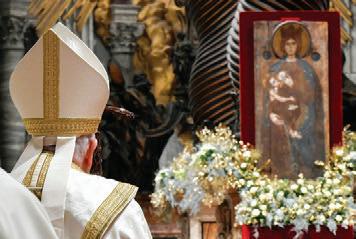
We pray that the dignity and immense value of women be recognized in every culture, and for the end of discrimination that they experience in different parts of the world.

Jesus is the greatest leader in history. Why should we care about how he was a follower?
There are three reasons. First, the Gospels clearly reveal that Jesus is the perfect follower of God the Father. We see this most dramatically in his prayer in the Garden of Gethsemane: “Abba, Father, all things are possible to you. Take this cup away from me, but not what I will but what you will” (Mk 14:36). In the Gospel of John, Jesus describes himself as the radically obedient follower of the Father at least a dozen times. Second, the Gospels reveal that the leadership of Jesus grows out of his relationship with the Father. The Father gives Jesus his mission, and the Father’s will is the criterion by which Jesus executes his leadership. Third, humility is the foundational virtue of Jesus’ leadership. It is because Jesus is the humble follower of the Father that he is the leader at whose name every knee must bend (Phil 2:7-11).
This is the pattern of leadership to which our Lord calls us. The foundation for everything we do as Christian leaders must be our filial relationship to the Father, established through Jesus, and our lowliness before the Father’s transcendent glory. ✢
— Joseph McInerney is vice president of leadership and ethics education for the Knights of Columbus.
IF YOU DON’T make prayer an integral part of your family life, you’re setting yourself up to fail.
We need healthy food to be strong, to be fit, to make sure that we can function. Daily prayer and the sacraments are our spiritual food. If we forget to eat or if we fail to eat in a healthy way, we can get sick. So, too, if we forget to pray, spiritual sickness can enter our lives. Having a regular time for your family to pray is essential.
Our Lord deserves time set aside for him when we can pray with no distractions. However, if that is something that you have to build up to, consider praying a decade of the rosary or morning prayers in the car with your children. Make a habit of saying prayers with your children every night.
Praying with the family can look different from season to season. There are certain times of the year when things are busier — your child’s sports practice goes late, and it gets in the way of scheduled prayer time. It’s important that you still pray as a family, but it’s also important to be flexible. We are called to live in the world, even though we’re not of the world, and it’s good for our children to be out there building virtue, being good examples to their teammates, being good examples to their peers. That is ultimately what we’re raising them to be: Catholics living out their faith in the world.
At the same time, we have to guard against the pitfall of inconsistencies when it comes to our

daily prayer life. “You know what, we won’t pray today because everyone has a lot of homework.” “We can’t pray today because there’s a football game.” “Dad can’t pray with you today because he has too much work to do.” Those inconsistencies build up and one day could become an avalanche that sweeps away the faith of our family.
Every parent needs to have a consistent habit of prayer. We can’t tell our children, “Do as I say, not as I do.” If we are not praying every day, if we are not practicing the works of mercy, if we are not loving others, we can’t expect our children to live a life loving others, being merciful, being consistent in prayer. ✢
DALLAS CARTER, a member of St. Michael the Archangel Council 16741 in Waialua, Hawaii, is an educator and the president of EPIC Ministry. He and his wife, Monica, have six children.
A Catholic investment firm is committed to giving individuals and institutions access to investments that align with Catholic social teaching. At Knights of Columbus Asset Advisors (KoCAA), we screen companies to ensure adherence to the U.S. bishops’ guidelines on socially responsible investing. We don’t invest in any companies involved with abortifacients, contraceptives, embryonic stem-cell research, human cloning, pornography and certain weapons manufacturers. We also exclude for-profit
health care companies that pay for services that are opposed to the Catholic faith. A moral theologian helps us make judgment calls when a company’s alignment with Catholic values is not entirely clear.
Second, a Catholic investment firm seeks to make investments that not only perform well but contribute to the common good. For example, there are many opportunities to invest in the energy and environmental sectors where a company, process or technology may generate significant benefits for the environment while also providing a competitive return.
Lastly, a Catholic investment firm expresses its core, faith-based values by financially supporting causes and charities that bolster the Church and are meaningful to Catholics. Profits from

funds managed by KoCAA contribute to the Knights’ charitable mission. Visit kofc.org/familyfinance for more resources to help you and your family. ✢
— Anthony Minopoli is president and chief investment officer of Knights of Columbus Asset Advisors and a member of the Knights of Columbus Board of Directors.
FOR YOUR MARRIAGE
If we don’t know and understand God’s plan for marriage, we can’t strive to live it
By Greg and Julie AlexanderTO BE INTENTIONAL in marriage means to have a sense of purpose and a deliberate plan to live out your vocation faithfully. It’s critical to be striving toward something, to be putting in the e ort to make your marriage what it ought to be.
What’s wonderful about our Catholic faith is that we don’t have to guess or gure it out ourselves. God has revealed all that we need to know in order to live happy and holy lives.
e Church de nes marriage as an intimate, exclusive, indissoluble communion of life and love, designed by the Creator and entered into by a man and a woman for their own good and for the procreation and education of their children.
It’s worth taking the time, as husband and wife, to sit down together and study the Church’s teachings about marriage and family, and to ask the Holy Spirit for understanding. As it says in Scripture, “Ask, and it will be given to you” (Mt 7:7).

There was a time when our marriage was far from what it ought to be. As we began our journey back to an understanding of the truth, we were blown away by what we read about marriage in Scripture and the catechism. No wonder we’d caused each other so much pain. We didn’t know what we were doing.
But when we got down on our knees and repented and asked God to come into our life, he met us with grace. And he has provided his grace each step of the way ever since. ✢
GREG and JULIE ALEXANDER direct a marriage apostolate called The Alexander House in Bulverde, Texas. Greg is a member of St. Joseph’s at Honey Creek Council 8521 in Spring Branch, Texas.
A cause for canonization has opened for Michelle Duppong, a North Dakota farmgirl and FOCUS missionary from a Knights of Columbus family
By Patti Armstrong
Michelle Duppong gestures joyfully to the beauty of the North Dakota Badlands during a visit to Theodore Roosevelt National Park around 2013.

What’s it like to call your li le sister a Servant of God as the Church investigates her for possible sainthood? Je Duppong, who was present when Bishop David Kagan of Bismarck, North Dakota, opened the canonization cause of his sister Michelle in 2022, admits, “ ere’s a surrealness to the whole thing.”
“Not many people have a ‘Servant of God’ sister,” said Je , a member of Sts. Ann and Joachim Council 11930 in Fargo. “ at’s the thing that gives the story an appeal; it can happen with just normal people.”
Michelle Duppong grew up on a farm in Haymarsh, North Dakota, the fourth of six children. Ken Duppong, a Knight of Columbus for nearly 50 years, and his wife, Mary Ann, raised their family to work hard, make time for fun, and, above all, to love their Catholic faith.
That faith became the cornerstone of Michelle’s life. Following college, she served six years as a FOCUS (Fellowship of Catholic University Students) missionary and then worked as director of adult faith formation for the Diocese of Bismarck. And when she was diagnosed with cancer in December 2014, it was Michelle’s faith that carried her to the end and drew others to her. She died Christmas Day 2015 at age 31.
Soon after presiding over Michelle’s funeral, Bishop Kagan began receiving letters from people attesting to the holy influence Michelle had on them both before and after her death. He officially opened the cause for her canonization during Mass at the Cathedral of the Holy Spirit on All Saints Day, Nov. 1, 2022.
“One of the dangers is that this sermon will become something of an obituary — and it’s not,” Bishop Kagan said in his homily. “Michelle lives. She no longer is with us physically, but it is our faith and our hope … with that condence which only God can give us … that she lives with him. And it is now for us to do our best so that the entire Church universal in time will come to know and to love her as we do.”
Michelle grew up working hard on the family farm, gardening, mowing, pruning and canning. “That exposure to yard and garden work is probably why Michelle and two others — three out of our six children — were horticulture majors,” said Mary Ann. “When there were extra vegetables, Michelle and the other girls sold them in town after Saturday morning Mass.”
Michelle’s older sister Sara fondly remembers working alongside Michelle as they did their chores. They would play in between such tasks as weeding the tree rows and harvesting potatoes, and listened to oldies music while shucking corn.
“One time, Michelle lost a watch she had go en for a present somewhere in the pasture,” Sara recalled. “How were we going to nd this watch in the middle of the pasture? We said a prayer to Our Lady of Mount Carmel, and she found it.”
Another time, they surprised some relatives who had arrived for a visit by coming in from herding sheep in the rain covered in mud.
With their dad a member of Bishop Ryan Council 4004 in Glen Ullin, Knights of Columbus activities were part of
the family culture. Sara recalls entering a K of C Christmas display contest with Michelle when they were teenagers.
“I was the ringleader and Michelle was my helper, pu ing up a Nativity scene and lights outside,” she said. “We lived out in the middle of nowhere, so who was going to see it? But we won rst place for our dad’s council.”
Fourteen-year-old Michelle also won rst place in a statewide K of C pro-life contest with a poem titled “Rose of Life.” e nal stanza read: “ e Creator alone has the power, / To know when to pluck His precious ower. / e bud, the bloom, the withering petal … / In this mankind must not meddle. / Only He knows the perfect hour.”
“She drew a rose and wrote the poem in calligraphy,” Mary Ann said. “Michelle had taught herself calligraphy just for the contest.” It was just one example, she said, of the e ort Michelle put into everything she did.
A er high school, where she was senior class president and valedictorian, Michelle went to North Dakota State University. It was during her junior year there that Michelle rst encountered FOCUS through her active involvement with
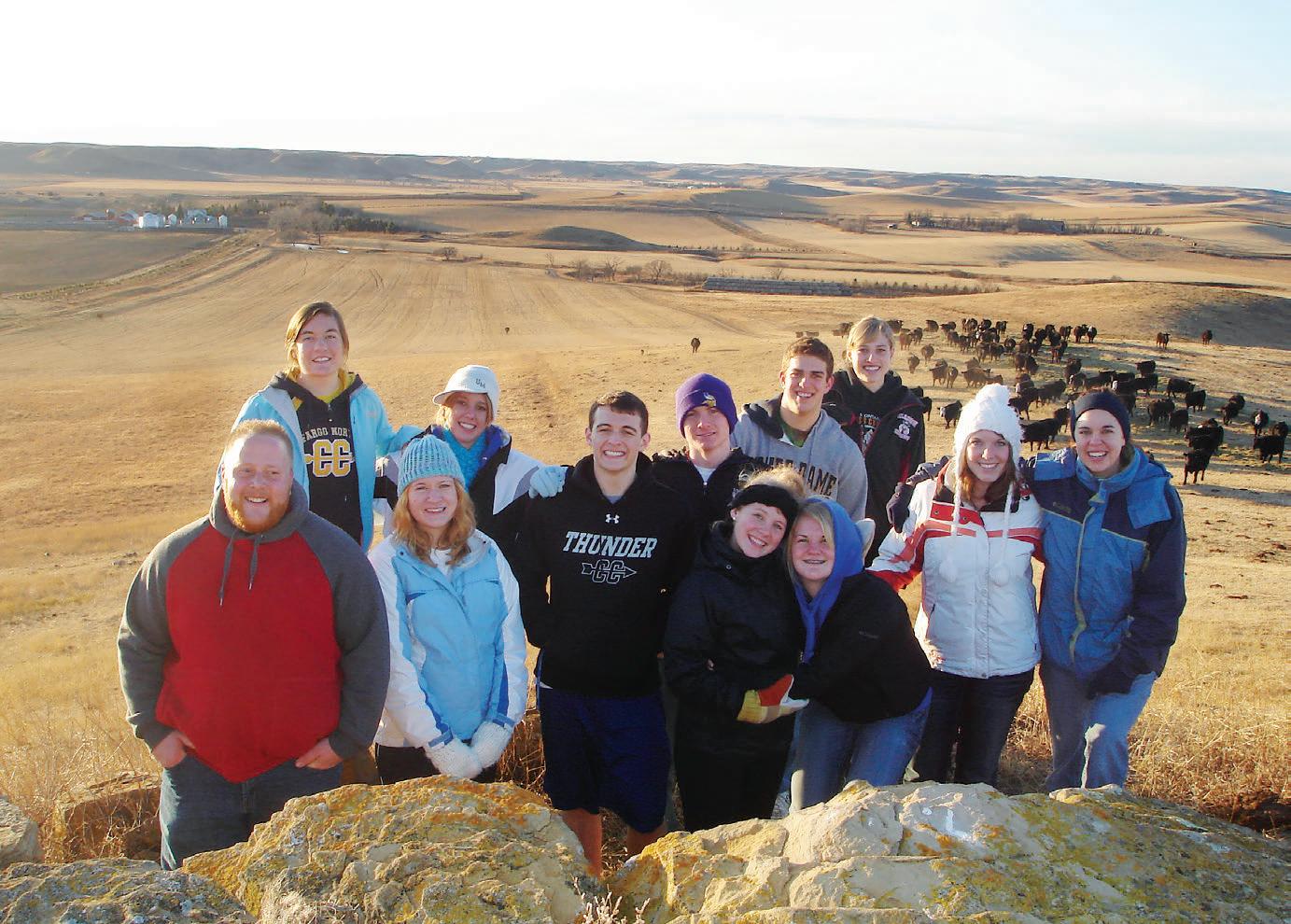

the Newman Center. She became a FOCUS missionary a er graduating in 2006 and mentored hundreds of students on four campuses over the next six years, bringing students to the Catholic faith and even in uencing young men and women in their vocations.
John Wanner, Michelle’s uncle and godfather, and a member of Montrose (Colorado) Council 1188, credits Michelle with inspiring his children to become involved with FOCUS in college and deepening their faith.
“She was joyful and fun-loving, but her faith was by far number one,” Wanner said.
Stephany Anderson was a freshman and sophomore at South Dakota State University when Michelle served there as a FOCUS missionary. ey remained friends a er Michelle le , and Anderson joined FOCUS herself a er graduation.
“Michelle was an example of joyful sacri ce and missionary zeal,” she said. “Part of outreach on campus was hosting events to meet new people and invite them into a deeper relationship with Jesus. I remember Michelle seeking out the new faces and spending intentional time with those who needed a friend. She, along with all the missionaries, modeled for me what it looked like to have the mission of Jesus always at the forefront of my mind and heart.”
Michelle and the other FOCUS missionaries invited students to join them for a daily Holy Hour at the Newman Center.
“Michelle spent the rst part of adoration down on her knees with her head bowed all the way to the oor,”
Anderson recalled. “It was a level of devotion and love for the Lord that I had not seen. It deeply struck me that she truly believed this was Jesus, and all her strength and love were drawn from this well.”
Bishop Kagan witnessed the same piety when Michelle became the director of adult faith formation for his diocese. “What I remember best of Michelle was her abiding love for the Mass,” he said. “She walked from her apartment every morning to Mass, which I celebrated at 6:30 a.m. She would come early and spend time in quiet prayer in my chapel. She a ended with such reverence and received holy Communion, and then would stay a er Mass in the chapel for thanksgiving.”
“She exuded a genuine love for Jesus and for others but was never showy about it,” he continued. “Wherever she went around our diocese, she wanted only to help others love Jesus and the Church, and in it, to nd their true home.”
In the fall of 2014, Michelle was diagnosed with ovarian cysts a er experiencing sharp pains in her abdomen for several months. “She was told it was nothing serious and they might even dissolve on their own,” recalled Mary Ann.
Feeling no relief by mid-December, Michelle scheduled outpatient surgery for Dec. 29 to remove the cysts. But the surgeon was shocked to discover Michelle’s abdomen was full of cancer. It was Stage 4. “Michelle was told there was

nothing they could do,” her mother said. “ ey recommended she go home for hospice care.”
Michelle accepted the prognosis with serenity. “Her a itude was, ‘If God wants me to go through this, I will go through this,’” Mary Ann said.
In a le er she wrote to Jesus two months before she died, Michelle thanked him for the gi of her life, for his love and mercy, and for her Catholic faith. “If you take me home soon,” she wrote, “please ll my family and friends, along with the multitudes who have been li ing me up in prayer, with joy and peace, knowing that your love wins in the end.”
e doctors initially gave her two months, but Michelle lived almost a year a er the diagnosis and continued to have an impact on many people. “Her Caring Bridge page alone had a quarter of a million hits,” Je said, referring to the website through which the Duppongs kept friends and relatives updated on her condition. “Some people were just following her story, seeing how she was touching lives.”
Ken acknowledged that even with faith, it was painful to watch the su ering his daughter endured.
“ ere was one time at Mayo Clinic in Rochester when she said that Jesus wanted her in the garden with him,” he recalled. “We knew what garden that was. It was like a sword in our heart.”

Above: U.S. bishops vote to allow Michelle Duppong’s cause for canonization to advance Nov. 16, 2022, while gathered in Baltimore for their general assembly.
Left: Ken Duppong (right) and his son, Jeff, take part in a K of C fundraiser for Special Olympics. Ken is holding Jeff’s daughter, Clara, who has Down syndrome.
e morning a er Michelle’s death on Dec. 25, 2015, her sister Lisa shared with the family that she had heard her voice, sounding radiant, say, “Leese, it’s beautiful.”
“ ings like that give you comfort,” said Ken, who is currently serving his h term as grand knight of Council 4004.
Another source of comfort is the growing devotion to Michelle that led to the opening of her cause. Right now, the cause is in the diocesan investigation phase. When that is complete, it will be forwarded to the Dicastery for the Causes of Saints at the Vatican. If approved, it will proceed for possible beati cation and canonization, which is simply the Church’s declaration that a person is united to God in heaven.
And that was always and only Michelle’s goal.
“She felt you had to try every day to win heaven,” Ken said. “Once I said to Michelle, ‘I just hope I make the cut o to purgatory,’ and she said, ‘No, Dad, you don’t want to waste time in purgatory; you want to go straight to heaven.’”
She expressed the same longing in the le er she wrote to Jesus in her nal weeks: “Jesus, I not only want to be a saint, but I want to be a great saint that leads others to you — all for your greater honor and glory, of course!” ✢
PATTI ARMSTRONG is an author and journalist based in Bismarck, N.D.
An interview with FOCUS founder Curtis Martin about the indispensable role of fathers and our universal mission to bring others to Christ
Curtis Martin would like to demystify this whole thing we call evangelization. Yes, as founder of the Fellowship of Catholic University Students, he has made evangelization his life’s work, and last year, Pope Francis appointed him as a consultor to the Vatican’s Dicastery for Evangelization. But, Martin insists, evangelization is not the work of specialists. It’s not the exclusive domain of priests, religious and people with advanced degrees in theology. It is the vocation of all Christians, by virtue of their baptism, to share the good news of Christ’s life, death and resurrection and tell others the story of how God is working in their lives. And it’s not rocket science.
“It’s the opposite of rocket science,” Martin said. “Teaching people how to tell these stories is a li le bit like teaching sh how to swim. We were made for this. ere are very few people who are rocket scientists; everybody’s called to be a saint. And part of that is living and then sharing the amazing adventure that Jesus Christ invites us to.”
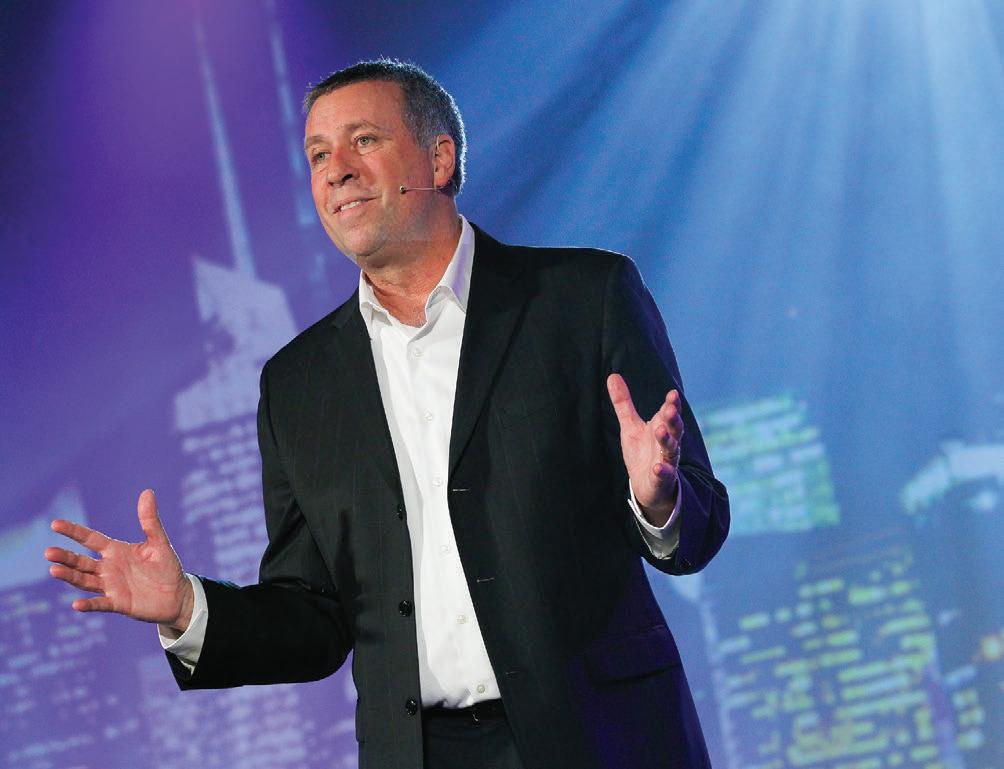
Since its founding in 1998, FOCUS has helped thousands of young people do that. e organization now places missionaries, most of them recent college graduates, at more than 200 college campuses in the United States, Mexico and Europe. eir work is simply to share the Gospel with students through personal relationships. FOCUS also organizes short-term international mission trips for college students and hosts large national conferences that draw tens of thousands of people.
Martin, a longtime Knight and member of Archbishop Fulton Sheen Council 7502 in Northglenn, Colorado, believes that the Knights of Columbus is uniquely positioned to evangelize men, particularly fathers. He recently spoke with Jonathan Reyes, the Order’s senior vice president of strategic outreach, about how to do that and why it’s so necessary.
COLUMBIA: It seems to me the real secret of FOCUS’s success and potency comes from a vision for sharing the Gospel that anyone can do. What is the secret to making this big, scary word, “evangelization,” less intimidating?
CURTIS MARTIN: We practice a three-step process that can be broken down into simple words: win, build and send. We want to win people into friendship, both with ourselves, but also more importantly, with Christ. We want to build them up in their knowledge and practice of the faith, and then we’re going to send them out so they can win over other people.
But before you can win anybody else, you have to be won yourself. So the rst step is, are we living in intimacy with Jesus Christ? Have we realized that living for him and with him is the most important thing in life? You can’t give what you don’t have. So it’s really important that we allow God to give to us rst.
e Apostles changed the world because they entered into an adventure at the invitation of Jesus Christ. Jesus Christ is inviting people into that kind of life-changing experience. Be a world changer, or what the Church calls a saint.
COLUMBIA: What have you come to learn about the young men who have been formed by today’s culture?
CURTIS MARTIN: We have to recognize that the culture is grinding men to a powder. ere are two massive false understandings about men. One is that you’re macho, and you’re going to blow stu up and break stu and you’re strong, but you have no control. And the other one is that you’re a wimp and that you’re easy to mock because you’re not very smart.
ose are both lies from hell. e reality of the ma er is that men are called to be great. And they need other men in their lives to do so. at’s the key.
I really do believe masculinity is not something you grow into. It’s something that’s imparted to you by the other men in your life: your father, your older brothers, your friends.
at’s why the Knights of Columbus, as a fraternal organization, is so important.
As a young man, you learn, rst of all, what it means to be a son. en as you grow, you learn how to be a brother. Unfortunately, that step is gone for many in our society. If you do have brothers and sisters, they live in di erent rooms and have their own social media; you don’t share life.
Brotherhood is an important step. When you learn how to love as a brother or a sister, you learn how to love people in a nonsexual way. But we’ve removed brotherhood, and there is horrible confusion today about what it means to love.
The next step is to be a husband, which then leads to fatherhood.
The first step is, are we living in intimacy with Jesus Christ? Have we realized that living for him and with him is the most important thing in life? You can’t give what you don’t have.
COLUMBIA: We can say that the culmination of the male personality is to be father, whether a natural father or spiritual father. How can we respond to the crisis of fatherhood today?
CURTIS MARTIN: In some ways, all earthly fathers are designed to fail, because we’re only pointing toward the heavenly Father. We can try really hard and do a great job, but we’ll still fall short. e expectations on a father are amazing. I have a relationship with my mailman, but I don’t get devastated when he’s late with my mail. I had a great earthly father — may he rest in peace — but the li le things he didn’t do well really got to me because my expectations were so high. God put that in us so that we could lead and at the same time point toward our heavenly Father.
We need a renewal of earthly fathers in a dramatic way, and the Knights of Columbus are positioned more than anybody else, I believe, to facilitate this.
So many young people that we serve today are living the reality of broken families and broken homes; they are wounded in a way that was not the case 25 years ago. As a result, a lot of young people don’t know who they are or how to love. ey’re desperate for love and identity, and they don’t have the true north star of Jesus Christ and the Catholic Church. All of that can be restored by a dad who, even in the midst of his weakness, loves and gets involved in his children’s lives.
COLUMBIA: When someone comes up to you and says, “I did everything right. None of my kids or three of my kids are not practicing the faith,” what encouragement do you give to them?
CURTIS MARTIN: First of all, it’s never over. And we don’t know the journey. At a certain point in time, Mary Magdalene looked like she was a train wreck, but she is St. Mary Magdalene. Don’t give up.
In his Confessions, St. Augustine tells the story of his coming to faith in Christ, and the role of his mother, Monica. ere are four things that Augustine describes: Monica cried. Monica prayed. Monica fasted. And Monica gave alms — and Augustine actually highlights that one.
We don’t want to be despairing. We need to weep and weep hard; we need to pray and pray hard; we need to fast and fast hard. And we need to give alms — we need to care for the poor. The Church’s teaching is that when you care for the poor — this flows right from Jesus’ words — you’re caring for him. The way that the saints talked about it is that, in some ways, God comes into debt to you when you care for his poor. Do you want him to answer your prayers? Care for the poor.
e other piece of it is, are you just going to Mass on Sunday, or is the faith something that is the center of your life and gives you joy? Because if you’re not a lot of fun to hang out with, I don’t want what you have. If the faith is not bringing the fruits of the Spirit — which St. Paul outlines in Galatians 5: love, joy, peace, patience, kindness, goodness, gentleness — if those things aren’t part of your life, you’re
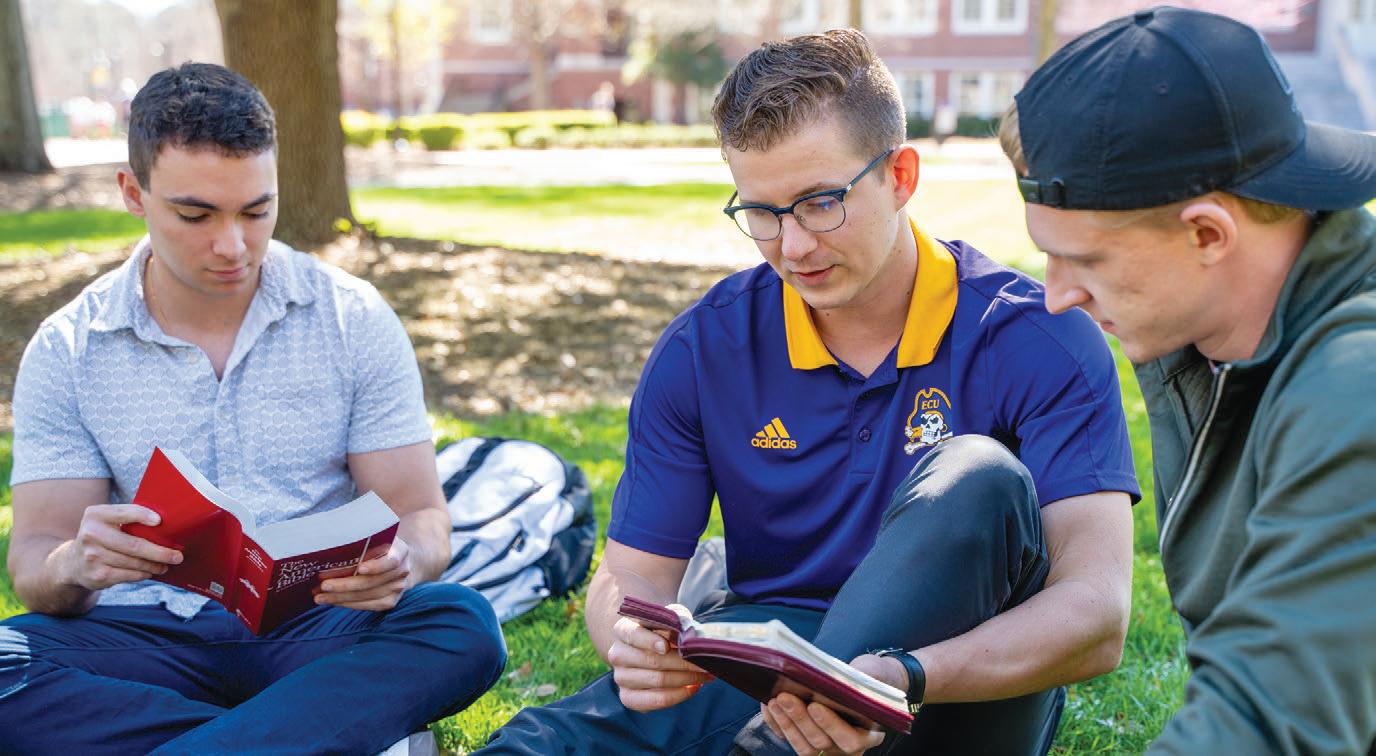
not a ractive. You’ve got to put the best things in life on the hook if you want to bait the hook e ectively. And that’s what the faith is all about.
True confessions: I’ve worked hopefully hard and hopefully well. But I have worked a lot trying to found and build FOCUS. And several of my older children have come to me in the last few months and said, “We’re grateful for what you did. We understand how big FOCUS is, but we would like the a ention that you gave to FOCUS.”
And it’s been a time in my life to repent and step back in certain ways and make time for my children and my grandchildren. I want to use this time in my life to listen and make reparation for not being as available as I could have been. Maybe there are a lot of Knights out there who have been busy building their career and doing important things and good things. But there’s nothing more important than your children, your grandchildren.
COLUMBIA: People who are concerned about the Church or the culture sometimes have a mindset along the lines of “Let’s hope it gets better in the future.” But you emphasize the urgency of preaching the Gospel, that right now is the time to put one’s faith into action.
CURTIS MARTIN: We like to say that this generation of believers is responsible for this generation — and it’s based upon some simple truths.
First of all, we believe that heaven and hell are the only things that really ma er. If you go to hell, nothing you did or acquired on earth ma ers at all to o set what a miserable
wretch you will be for the rest of eternity. And by comparison, if you didn’t nail it here on earth with earthly treasures, but you die and go to heaven, you win.
e second piece is that we don’t believe in reincarnation. Every person has one life, and you get to nd and love and serve Jesus Christ in this life. So, for those of us who already know him, we should take those two realities and say, “We must work with urgency.” Because in 150 years, every single man, woman and child on earth today will be gone and will have been replaced by other men, women, children. is is where the Knights are uniquely positioned, maybe more than any other institution within the Church in the world. Two million members, men who are ready to serve and who are already serving powerfully. Incredible corporal works of mercy are being done, extraordinary caring for the poor, which is absolutely essential to being a follower of Christ.
But we’re a composition of body and soul. e spiritual works of mercy, sharing the Gospel, teaching the faith — those things are actually more important than the corporal works of mercy because the soul is more important than the body. And the only way your body lives forever is if your soul does. When you feed somebody, they get hungry the next day. When you evangelize them, they can live forever.
To watch someone who was dead in sin, living for themselves, all of a sudden realize that Jesus Christ loves them and wants to forgive them, and they turn their life around — that story is so extraordinary, and it shoots right into eternity. It goes to the heart of what FOCUS — and the Knights of Columbus — is all about. ✢
On the night of April 14, 1912, as RMS Titanic plowed through the Atlantic, all appeared to be in order. It was to prove a tragic illusion.
e ocean liner had set sail with much fanfare from Southampton, England, on April 10, 1912. e ship made rst for the French port of Cherbourg to pick up passengers, crew and supplies, and then to Queenstown, Ireland. From there, the Titanic was bound for its nal destination — New York City — due to arrive on the morning of April 17.
But the ship never did arrive: e Titanic struck an iceberg at 11:40 p.m. on Sunday, April 14, and sank at 2:20 a.m. on Monday, April 15, with the loss of 1,516 lives.
Over a century later, the ship deemed “unsinkable” still haunts the public imagination. It has become a symbol of many things: luxury, innovation, social and class divisions, technological hubris. Yet, it endures as a sign of something else besides: the heroism of the priestly vocation. For as that Second Sunday of Easter drew to a close — a day that later became synonymous with Divine Mercy — three ordinary Catholic priests were called to become extraordinary martyrs to charity.
Of the 2,224 passengers on board the Titanic , three were priests: Father Thomas Byles, 42, from England; Father Juozas Montvila, 27, from Lithuania; and Father Josef Benedikt Peruschitz, 41, from Germany.
However glamorously the sea crossing may have been portrayed by the shipping company, for the priests, as for many passengers, it was simply a means to an end. Father Byles, a convert to Catholicism, was traveling to New York City to o ciate at his brother’s wedding. Father Montvila was to begin life in that same city at a parish for Lithuanian immigrants. Father Peruschitz, a Benedictine monk and teacher, was heading to Minnesota to help start a school.
What linked the men was that which de ned them: their priesthood. However, they also shared another quality, and that was their very ordinariness. None of them was considered remarkable by their superiors.
e main reason Father Peruschitz was chosen to go to the United States was because he was deemed young enough to adapt to the challenge. His brother monks at Scheyern Abbey in Bavaria had known a good priest and monk, but a man who in no way stood out. In fact, a er his death the monastery struggled to say anything about him other than he had met his end as any monk would be expected to do.
Ordained in 1902, Father Byles had struggled for years with his health. He started his ministry in London but soon was sent to the countryside of Essex to escape the strain of city life. A small rural parish was thought about right for his gi s and aptitude.
Father Montvila, serving as a vicar in what is today northeastern Poland, had a ended to the spiritual needs of the Unitates, Eastern-rite Catholics whose presence was unwelcome in czarist Russia. As a result, he was denied permission by the authorities to minister in his homeland. So that he could once again openly serve as a priest, his superiors dispatched him to America, where his brother, who lived in Brooklyn and helped cover his fare on the Titanic, was waiting to greet him.
“In the midst of them was a tall figure … [who] climbed upon a chair or a coil of rope so that he was raised far above the rest. His hands were stretched out as if he were pronouncing a blessing.”



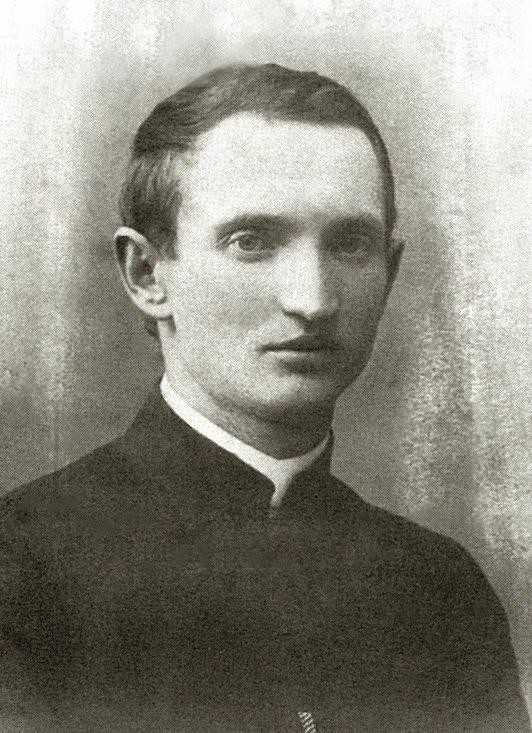
Reading their biographies, one can imagine the largely uneventful lives — at least in the eyes of the world — that might have followed their ocean journey. Yet, on the Titanic, all three men received a call within a call, as their vocation to priestly service took an unforeseen turn.
Survivors would later describe Father Byles and Father Peruschitz celebrating holy Mass each day for passengers in steerage and spending time with passengers in the ship’s library. Lawrence Beesley, an English schoolteacher who later wrote a book about his Titanic experience, recounted: “In the middle of the room are two Catholic priests, one quietly reading — either English or Irish, and probably the la er — the other, dark, bearded, with a broad-brimmed hat, talking earnestly to a friend in German and evidently explaining some verse in the open Bible before him.”
On Saturday, April 13, Father Byles heard confessions for hours in preparation for the following day: the Second Sunday of Easter, then known as Low Sunday and today as Divine Mercy Sunday. On April 14, he delivered a homily, in English and French, on the theme “Our prayers and the sacraments of the Church are spiritual lifeboats taking us back to God”; Father Peruschitz delivered the homily in German and Hungarian. Both priests preached on the necessity to have a “lifeboat in the shape of religious consolation at hand in case of spiritual shipwreck.”
Later that night, as word spread that the ship had struck an iceberg, Father Byles and Father Peruschitz descended below decks to steerage, where fear was descending into su ocating panic. e priests quickly realized that saving souls was even more important than saving lives. Perhaps, too, they sensed that God had been preparing them for this moment.
Compared to the other priests, li le is known of Father Montvila’s movements that night. Reports simply state that “the young Lithuanian priest, Juozas Montvila, served his calling to the very end.” ere are witness accounts of Father Byles and Father Peruschitz, though, and the picture that emerges is remarkable.
An eyewitness later told America magazine: “When all the excitement became fearful, all the Catholics on board desired the assistance of priests with the greatest fervor. Both priests aroused those condemned to die to say acts of contrition and prepare themselves to meet the face of God.”
en the priests began to organize the evacuation of women and children, escorting them upward through the various decks while leading the rosary and giving general absolution. Witnesses later reported that the dominant characteristic of Father Byles was his presence of mind.
Bertha Moran, an Irish garment worker traveling thirdclass, would tell e Evening World: “Continuing the prayers, he led us to where the boats were being lowered. Helping the women and children in, he whispered to them words of comfort and encouragement.” Seeing the rst batch of women and children safely aboard lifeboats, he declined an o er to join them.
Another young Irish woman, Ellen Mockler, would later say: “After I got in the boat, which was the last one to leave, and we were slowly going further away from the ship, I could hear distinctly the voice of the priest and the response to his prayers. Then they became fainter and fainter, until I could only hear the strains of [the hymn] ‘Nearer, My God, to Thee’ and the screams of the people left behind. We were told by the men who rowed our boat that we were mistaken as to the screams and that it was the people singing, but we knew otherwise.”
The Titanic, seen here docked at Southampton, England, on April 10, 1912, was the world’s largest ship at the time of its maiden voyage.
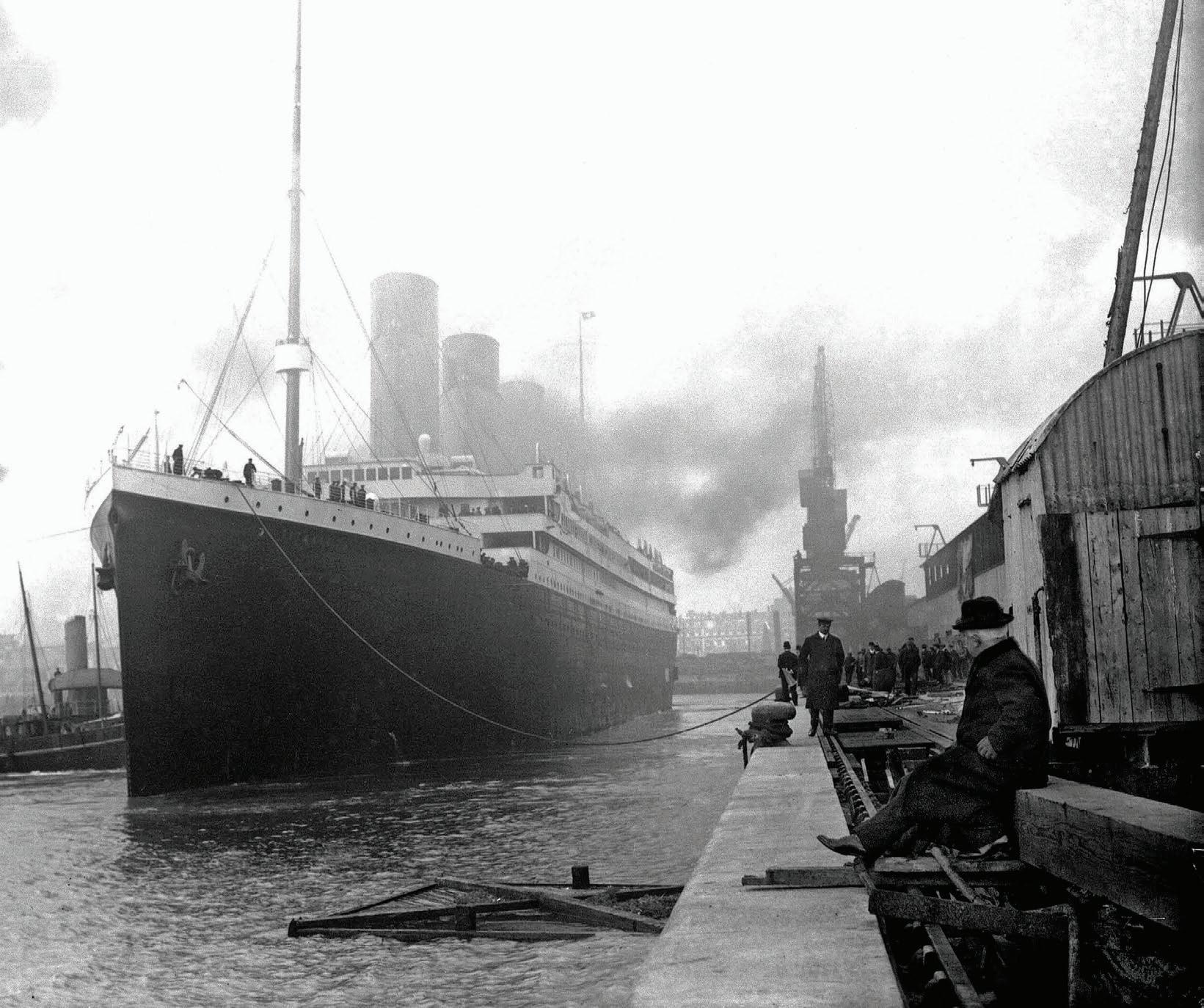
Another passenger on that last lifeboat, Charlo e Collyer, told reporters: “On the boat deck that I had just le , perhaps 50 men had come together. In the midst of them was a tall gure … [who] climbed upon a chair or a coil of rope so that he was raised far above the rest. His hands were stretched out as if he were pronouncing a blessing. … Father Byles stood there leading those doomed men in prayer.”
e ship nally sank at about 2:20 a.m., its stern rising high in the air before plunging into the freezing waters of the North Atlantic. None of the three priests was seen again. All had been o ered places on lifeboats; all had declined.
Reading accounts of these events, it is easy to assume — or hope — that one would also act with such integrity. Yet, it is
important to recall that in the ship’s last hour, the mood on board the Titanic became one of sheer terror. It is in this context that the witness of Fathers Byles, Peruschitz and Montvila needs to be pondered. e moment it became clear that the ship was doomed and there were not enough lifeboats for all the passengers called for more than the courage of a hero; it called for the courage of a martyr.
Nearer, my God, to Thee, nearer to Thee! E’en though it be a cross that raiseth me; Still all my song shall be nearer, my God, to Thee… ✢
K.V. TURLEY , a London-based writer, journalist and filmmaker, is the National Catholic Register ’s U.K. correspondent.
With Order support, conservation experts are creating digital scans of Ukraine’s churches to protect the country’s cultural heritage
By Karolina ŚwiderThe nine towers of the 18th-century Holy Trinity Cathedral in Novomoskovsk, Ukraine, stand tall against the sky. The silhouette of this Orthodox church — the largest entirely wooden church in Ukraine — is truly exceptional, its cluster of towers, each crowned with a pearshaped dome, more reminiscent of a small city than a single building. It was built, incredibly, without a single nail.
Unfortunately, this pearl of what is called Cossack Baroque architecture is currently located less than 75 miles from the front line between Ukraine and Russia; rockets regularly fly overhead. And it is far from the only church endangered by the war. As of February 2024, the United Nations has verified damage to nearly 130 religious buildings since Russia’s invasion of Ukraine.
In response to this threat, conservationists are racing to create detailed records of Ukraine’s historic churches, a project they are tackling with support from the Knights of Columbus and Red Arch Cultural Heritage Law & Policy Research, a U.S.-based nonprofit organization specializing in the protection of cultural heritage. Since October 2023, experts and students have been using K of C-funded laser-scanning equipment to produce 3D maps of vulnerable wooden structures that could be used to restore them if they are damaged.
With each church destroyed by the con ict, a piece of Ukraine’s cultural and artistic heritage is lost — and the Knights of Columbus, which counts more than 2,000 members in Ukraine, has a responsibility to act, said State Deputy Youriy Maletskiy.
“It is through architecture, through the churches that exist, that one can understand the very spirituality of the people of a country,” Maletskiy explained. “Our task is to preserve this heritage for future generations and multiply it.”
This is not the Knights’ first project related to reconstruction. In 2017, after the town of Karamles, Iraq, was liberated from ISIS, the Knights of Columbus donated $2 million to help the town rebuild. The funds enabled the

restoration of more than 500 houses, as well as the local church of St. Addai.
is time, the Order, working with Red Arch, is focused on preventing the loss of invaluable religious and cultural heritage.
“When the full-scale invasion of Ukraine started on Feb. 24, 2022, the first thing everyone thought about was obviously protecting life and protecting civilians,” said Carolyn Guile, Red Arch’s executive director. But, she went on, “there is a direct connection between the protection and support of civilian life and culture, and the protection of the cultural heritage that they create and use. You could say a deliberate attack on a society’s cultural heritage is a form of cultural cleansing.”

Holy Trinity Cathedral in Novomoskovsk — the largest wooden church in Ukraine — was one of the first buildings scanned by the conservation team.
The 18th-century structure, seen here in October, is located less than 75 miles from the current front line between Ukrainian and Russian forces.

Ukrainians are acutely aware of this; they have been fighting for the recognition and preservation of their cultural identity for centuries. In the 19th century, the Russian Empire went so far as to officially forbid the construction of wooden churches in the territory of Ukraine to dilute the specificity of Ukrainian design. Nevertheless, no country in Europe today has as many wooden churches as Ukraine.
“These monuments are very special in terms of architectural forms and technologies,” explained Mykola Bevz, vice president of the Ukrainian National Committee of the International Council on Monuments and Landmarks and head of the Department of Architecture and Conservation at Lviv Polytechnic National University. “They are completely different from Norwegian churches, Polish churches; completely different from Russian churches.”
e buildings vary in structure, style and construction technique depending on the region, but they all have at least one thing in common: “ ey are very delicate,” said Bevz, whose department is working closely with Red Arch on the project. “ ey can easily be burned; they don’t necessarily need to be shot at — even a remote re can set these objects on re.”
The first scans took place last fall in eastern Ukraine, close to the front. To start, Bevz and his colleagues selected 11 of the most valuable examples of wooden and sacred architecture in the region, most from the 18th century and early 19th century. The team worked with a sense of urgency, in exposed Eastern areas where lingering can be dangerous. The process can take anywhere from 10 hours to a few days, depending on the intricacy of the architecture and other factors.
e scanners use lasers to take millions of measurements of each building, and computer so ware can render the data, called a point cloud, into a 3D model. is detailed mapping has many potential uses: Not only does it provide a digital record of unique pieces of architecture for study and research, it could facilitate faithful reconstruction or conservation work.
Opposite page: Ihor Bokalo (left), an associate professor at Lviv Polytechnic National University, speaks with members of Sts. Borys and Hlib Council 17740 in Fastiv and Father Stanislav Radchuk (right), as he works on scanning the Church of the Intercession of the Most Holy Theotokos in February. Father Radchuk is a priest at the church, as well as a military chaplain of the Orthodox Church of Ukraine.
“Every church is like a living organism. It gets sick very often, just like a person,” said Bevz. “Digital technology allows us to model the object, to identify all its diseases. And then we can make complex diagnostics.”
e digital records could also be used in future court cases related to a acks on cultural heritage.
“Most Ukrainian museum collections are not digitized,” explained Yuri Yanchyshyn, a wood preservation expert who has been a part of the project from its beginning. “ is is a huge problem, because some of the stolen works of art, from Kherson or Mariupol museums for instance, will never be returned to Ukraine, as it is impossible to document in court that those objects belonged to those museums.”
While sacred architecture cannot be stolen, it can be destroyed, and the laser scans could serve as legal proof that a church which is no longer standing once existed.
The experts scanning the churches are motivated not only by fascination with the architecture but by the knowledge that this project is meaningful for the people of Ukraine.
“The team scanning highlighted how the locals were so grateful and happy to see them show up,” said Guile. “They cared about this.”
Parishioners are taking an active interest in the advancement of the project. One gentleman from Novomoskovsk — a city of nearly 70,000 that will soon change its name to Nova Samar — has already sent Bevz a dozen le ers to get updates about Holy Trinity Cathedral because he is worried about his church.
In Fastiv, where the Church of the Intercession of the Most Holy Theotokos was scanned in February, Father Vitalii Martsyniuk reflected on the importance of sacred architecture in the life of the Ukrainian people: “Whenever the enemy came to destroy our culture, our language, our traditions, the churches were the first targeted, as they are a way to unite people, and they constitute a nation’s identity,”
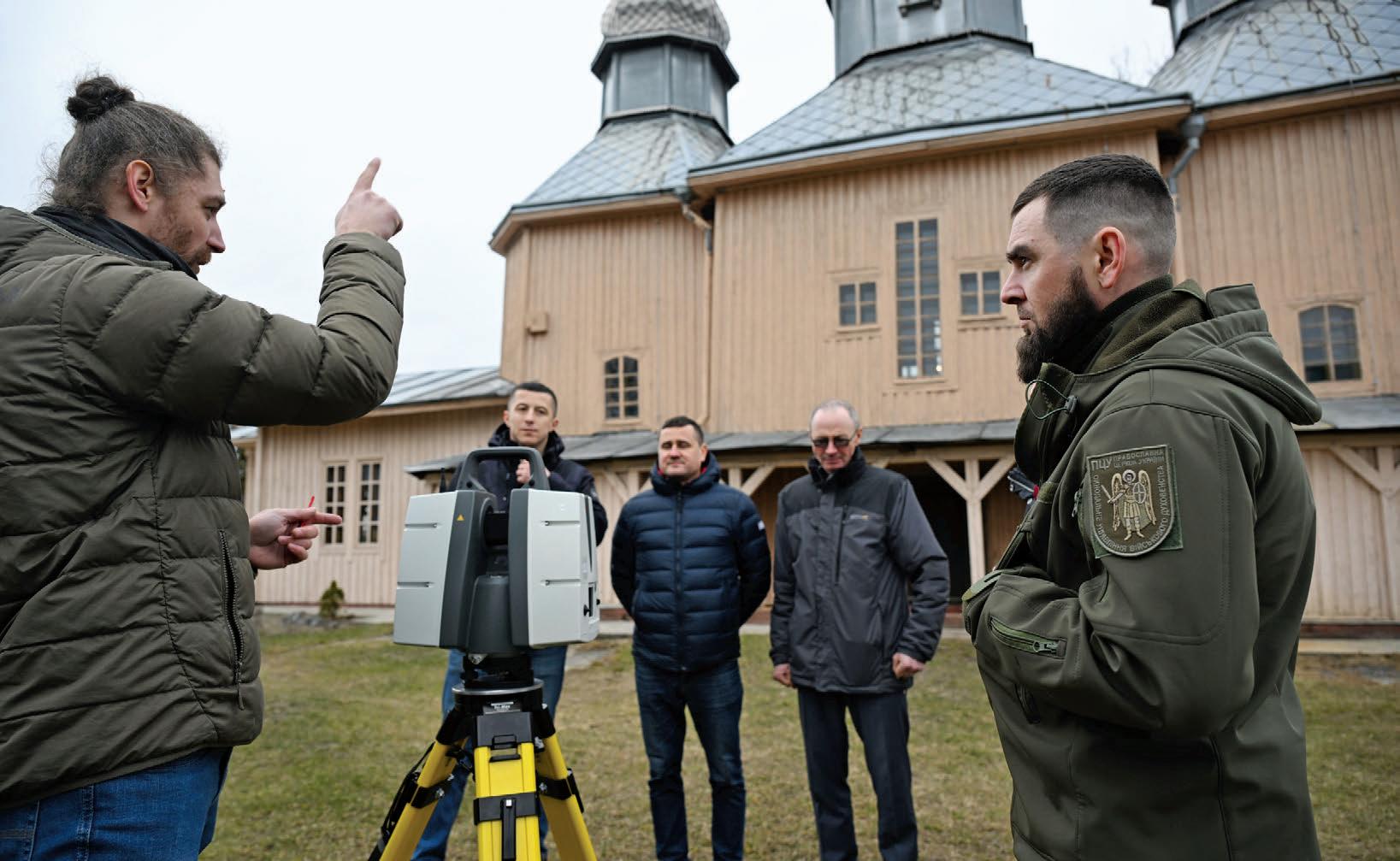
said Father Martsyniuk, who serves as the chaplain of Sts. Borys and Hlib Council 17740.
“These churches have great value,” added Oleksandr Kvechuk, a member of the same council. “This is our story, our culture. Destroying them is destroying our history — and without history, there is no future.”
Ihor Bokalo, associate professor in the Department of Architecture and Conservation at Lviv Polytechnic National University, said that the scanning project gave him a new understanding of the purpose of his work.
“It is not about the conservation itself, but about the people using this object,” he said. “We had an understanding of preserving it for future generations.”
With somewhere between 800 and 2,000 wooden churches in Ukraine, there is still plenty of work for the scanning team. Once the two last churches from the pilot list of 11 are completed, the team will move forward to work on another 25 structures.
Red Arch also aims to advance research and education in Ukraine. “We would like to support the acquisition of equipment for Ukrainian conservation labs so they could be on the cutting edge of their own conservation research,” Guile explained.
e architectural school in Kharkiv has already invited
Mykola Bevz and his students to Odesa, in southern Ukraine, for a demonstration of and training on using the new scanning equipment. e city’s historic center is included in the UNESCO World Heritage List of historical landmarks with international legal protection.
The project launched by Red Arch in partnership with the Knights of Columbus goes far beyond the preservation of material culture and architecture. The scanned churches are important primarily in reference to people: those who built them centuries ago, those using them today, and future generations, who will find preserved in them a unique part of their national identity.
Trinity Cathedral in Novomoskovsk is still vulnerable and could still be destroyed, but it can now also be rebuilt, and will not be forgotten.
“I really would like to express our profound thanks to the Knights of Columbus for the partnership in this project and for their immediate recognition of why it’s important,” said Guile. “Structures like this are important not only for the spiritual health of local communities, but for their very life.”
To learn more about the work of the Knights of Columbus Ukraine Solidarity Fund, visit kofc.org/ukraine . ✢
As the Church unites in Alleluias every Easter, we invite Jesus to pierce the darkness with joy and hopeBy Amy Welborn
During Lent, we don’t shy from death. Walking with Jesus to Calvary, the death to self, death to sin. Lent is lived in a context of death, always.
In 2009, my Lent was marked by yet another kind of death: the mortal, earthly kind. Just a few weeks before Ash Wednesday that year, my 50-year-old husband dropped to the ground a er a few minutes on a gym treadmill. e woman who was on the machine next to him later shared with me what she’d witnessed. She was sure he had died immediately.
So that was Lent, me with two young sons, aged 7 and 4, in a city we’d moved to only a few months before. ere was no problem focusing on God, le ing go of earthly a achments, living in a sober, subdued mode; no problem doing a whole lot of prayer. A lot.
But then what? e easiest, most organic-feeling Lent turned, ironically, into the most challenging Easter. I vividly remember standing in Mass at the Easter Vigil Mass that year and singing Alleluia that rst time. Yes, I sang with everyone else, but I was dutiful more than anything else, for it struck me as strange and hard in that moment. I was forced to ask myself: Do I really believe this?
It’s a question worth posing to ourselves regularly as we pray, sing and proclaim. Do I really believe “Our” Father and not just mine? Do I really believe that heaven and earth are full of God’s glory? Am I really heartily sorry?
I’m not suggesting that we should only u er the words when we perfectly understand them and wholeheartedly accept them. I’m looking at it from the other side: How can saying the words help me believe?
ere are many kinds of prayer. We pray in quiet solitude. We pray with others. We pray for others. We say words, sing, gesture. We meditate on Scripture. We ponder God’s presence in his creation. All of it, as St. érèse of Lisieux says, is “a surge of the heart; it is a simple look turned toward heaven, it is a cry of recognition and of love, embracing both trial and joy.”
e most ancient manner of articulating the surges of our hearts is through the words and the forms that have been
passed down to us, which are even divine gi s — the Psalms, Jesus’ own words, the prayers of our tradition, the words and structures of the liturgy. Words like Alleluia
St. Paul says in his Le er to the Romans that we do not know how to pray as we ought. He doesn’t mean that we need a class in prayer, but more that we don’t know what it is we should be praying for, what we truly need. Our self-understanding is limited, especially in the cosmic context. Ask Job what God had to say to him about that.
But, Paul says, the Spirit comes to help us in our wrong-headedness. And since the Spirit dwells in the Church and has guided it over the centuries, one of the ways the Spirit helps us pray is through the prayer of that same Church.
I may not feel like I need to be forgiven or much less to forgive others, but in praying the Lord’s Prayer, my rebellious self is guided in the right direction. I may feel hopeless, but praying Psalm 23 recenters me in ways that my solipsistic rambling can’t begin to do. I may feel alone in the universe, but ge ing myself to Mass and gathering in communion with others, with the Lord and with those in heaven reminds me, most decidedly, that I am not.
And so, we gather each year by the ickering light of the Paschal candle, returning to the word that we’ve le behind for the past several weeks, and we sing: Alleluia!
In the crowd packing a church at the Easter Vigil, the crowds raising their voices around the world, where do their Alleluias come from?
For every person — every single one — the joy exists, grows, is fought for in the context of loss. Not just the loss that is the death of someone we love or the inevitability of our own death. Alleluias are sung by those who have lost their marriages, who live alienated from family members; by those who have lost a sense of purpose or meaning, who are struggling with ma ers of faith and doubt. e Alleluia resounds from a Body whose members have lost their youth, their health, their jobs, their dreams.
In the midst of all of that loss, the Spirit teaches us to pray. Alleluia

We can see our own loss-framed Easter moments in the rst Easter, in the hearts of the women gathered at the tomb.
Luke tells us that Jesus had healed Mary Magdalene of a profound possession. Possessed by seven demons — the number seven always signi es completeness in Scripture — poor Mary was completely engulfed in darkness. en Jesus entered her life and drove out the darkness; what could she do but follow him?
And there she was at the tomb, still following. There to perform her religious duty, mourning, deep in loss and now shock, for she’d seen that the tomb was empty. Where is Jesus?
Wait. A man is there, and he asks her why she’s weeping. She tells him. And then what does he say? Her name: Mary
He lives! He conquers darkness, death and loss in each of our lives, now and forever, and calls us — shocks us, even — into light and life. Not abstractly, not impersonally, but calling us by name.
And so while each of us singing Alleluia on Easter lives in a world of loss, we’ve also been called by name — baptized, in communion through the Eucharist, wholly one now, not just because of our shared humanity, and not even because of the common human experience of loss, but because Jesus lives. Even in the mystery of the su ering that is life on earth, he brings us light and life.
We may not feel it. We may still be confused, sad and even angry, and we will certainly struggle, but the cycle of the liturgy — the prayer given to us — that every year takes us
He conquers darkness, death and loss in each of our lives, now and forever, and calls us — shocks us, even — into light and life. Not abstractly, not impersonally, but calling us by name.
through this rhythm of death and life, darkness and light, forces us to get beyond our own limitations and hear the good news, sometimes despite ourselves.
None of us come to that Alleluia moment completely unprepared, though, do we? For God has been working in our lives, hinting, whispering.
For me, the rst hint that Alleluia might be possible revealed itself at my husband’s casket. I had dreaded the moment. I had not seen his body since the hospital, and even then, I could not bear to get close.
So I approached his open casket, shaking. It was impossible that just a few days before he had been alive and now he was gone from our lives forever. To see his lifeless body? Terrifying, ridiculous, even outrageous.
I arrived, and at last looked. What I saw was familiar, but strange, for something was missing — simply: him. At that moment, that very moment, I heard a voice, a memory, a recollection of words I had heard so many times before — the words of Jesus to Mary Magdalene: Why do you seek the living among the dead?
It was shock, but of a di erent kind now. In the non-recognition, there was a new recognition — of an old familiar truth I’d heard and wri en about and even taught and, in my limitations, had resisted.
Yes, the tomb is empty. Alleluia ✢
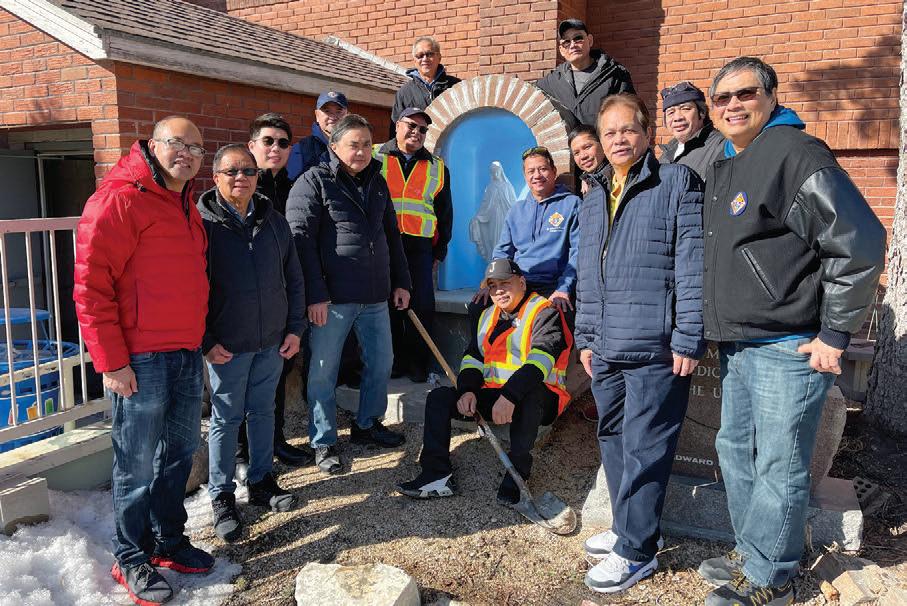
A group of rst-year seminarians from the Diocese of Evansville, Ind., visited ve North American shrines dedicated to Catholic saints and martyrs with support from Newburgh (Ind.) Council 8746. e council donated more than $5,000, raised at its recent golf scramble, for the seminarians’ pilgrimage.
Ocean City (Md.) Council 9053 sponsored a “living rosary” for 70 children and parents from the religious education program of St. Luke Parish and St. Andrew Mission Church. As the families prayed the luminous mysteries together, they also learned about saints related to each mystery.
Knights from Msgr. Blecha Council 2055 in Menomonie, Wis., and Pope John XXIII Assembly 1203 in Durand helped lead a Eucharistic procession through downtown Menomonie. More than 100 people, including parishioners from St. Joseph Catholic Church and students from the Newman Center
at the University of Wisconsin-Stout, walked half a mile from the church to the Newman Center, where the procession ended with Benediction led by pastor and council chaplain Father John Manohar.
Our Lady of Fatima Council 4315 in San Antonio presented a Mass kit to Father Luis José Barajas de la Garza, a son of St. Jerome Catholic Parish who was ordained last year for the Diocese of Mayagüez, Puerto Rico. e council supported the new priest during his seminary formation with prayers and nancial aid through the Refund Support Vocations Program.
Bishop Hafey Council 4507 in High Point, N.C., raised more than $11,600 at its annual charity golf tournament, donating the proceeds to the retirement fund for the Oblates of St. Francis de Sales. Immaculate Heart of Mary Catholic Church in High Point, which the council serves, is entrusted to the Oblates.
More than 300 people a ended a fundraising dinner hosted by Memorare Council 3476 in Seaford, N.Y., to support vocations to the priesthood. Fourteen seminarians from the Diocese of Rockville Centre received checks for $1,000 during the event, which began as a breakfast fundraiser more than 40 years ago. In that time, the council has raised about $200,000 to support 25 seminarians.

Members of Bishop John J. Kaising Council 14223 at Army Garrison Yongsan-Casey in Seoul, South Korea, carry the canopy over the Blessed Sacrament during a Eucharistic procession outside Our Lady, Queen of Peace Catholic Church at Camp Humphreys.

Travis Henry (left) and Brad Bole from Holy Family Council 7441 in Chetopa, Kan., grind sausage for the council’s annual sausage sale. The Knights raised $3,500 for the archery team from Oswego Unified School District 504, helping the students cover travel and lodging expenses for an outof-state competition.
Santa Maria Gore i Council 12836 in Edmonton, Alberta, donated CA$4,000 from its fundraising gala to the Kids with Cancer Society.
Several councils from the Erie (Pa.) Chapter and Archbishop John Mark Gannon Assembly 943 purchased $450 worth of school supplies for the Sarah A. Reed Children’s Center, which provides mental and behavioral health care for children, teens and families.
Knights from St. Katharine Drexel Council 11177 in Cape Coral, Fla., were recently contacted by a local woman who saw an advertisement for their upcoming charity car show. Her father, an avid car enthusiast, was terminally ill and not likely to live long enough to a end the event, so she asked if the council could bring the cars to him. Working with local classic car clubs, the Knights delivered, pu ing on a show with six muscle cars at the man’s home; he died just one week later.
Father James Quinn Council 7556 in Norwalk, Iowa, held a breakfast at St. John the Apostle Catholic Church to raise funds for a local man in need of a kidney transplant and his family. e Knights were able to present the man with more than $8,000 to help cover medical expenses.
Members of Macdonald-O’Neill Council 2032 in Rhinelander, Wis., worked with sta and students from
Nativity of Our Lord Catholic School to prepare and serve a spaghe i dinner to the school community. In addition to fostering camaraderie, the dinner raised more than $8,800 for much-needed educational equipment.
Members of St. Catherine of Siena Council 15217 in Pi stown, N.J., participated in a food harvesting event with America’s Grow-A-Row, an organization that grows and harvests produce for local food banks, at the organization’s Milford farm. Volunteers collected 24 shipping containers of food, enough to feed more than 84,000 people.
Members of Dayton (Ohio) Council 500 served as judges for a science fair at St. Peter Catholic Church in Huber Heights sponsored by two local homeschooling groups, John Paul the Great Home Educators and Immaculate HEART Co-op. e Knights assessed more than 20 projects presented by students ranging from elementary to high school.

Knights and family members from Bacnotan Council 4490 in La Union, Luzon North, prepare to plant trees at St. Michael the Archangel Parish. The council received 300 free seedlings of various fruit trees from the city’s Environment and Natural Resources O ce and partnered with the Diocese of San Fernando de La Union to distribute them among nearly 30 Catholic parishes in La Union province so that any fruit they produce can benefit community members in need.

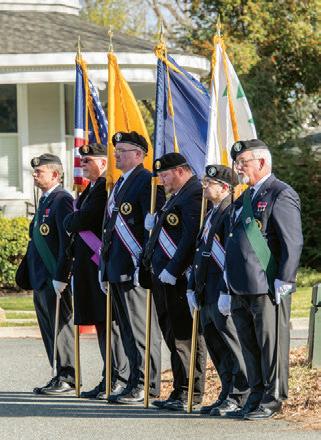
Knights and family members from Luzon South District #16 participated in a “Save Our Sunset, Save Manila Bay” demonstration last year at Rajah Sulayman Park. A group formed in 2019 to promote Pope Francis’ encyclical Laudato Si’ organized the event to protest proposed development along Manila Bay that could harm local ecosystems.
More than 40 students from St. Patrick Elementary School, St. Mary’s Academy and John F. Kennedy Catholic Preparatory School participated in the Catholic Citizenship Essay Contest hosted by Father John LaFarge, S.J. Council 4012 in Yorktown Heights, N.Y. In their essays, participants were prompted to re ect on how the Church can evangelize in the digital age.
On the feast of the Epiphany, Knights from Joseph E. Binker Assembly 1432 in Daleville, Ala., and other parishioners from Our Lady of Lore o Catholic Church removed 220 wreaths from the graves of veterans at Daleville Memorial Gardens.
For 25 years, Marian Council 3753 in Norwood, Pa., has worked with the Lions Club of Spring eld to collect used eyeglasses and cell phones to be repaired and donated. More than 20,000 pairs of glasses have been sent to developing countries through the partnership, and 5,000 cell phones have been donated to people experiencing homelessness.
Queen of the Most Holy Rosary Council 12302 in Spring Grove, Ill., purchased copies of the U.S. Declaration of Independence and Constitution to give to about 500 students at Richmond-Burton Community High School. e council has donated the booklets every year since 2019 to educate students about the principles and values on which the United States was founded.
Since the 1960s, members of Crookston (Minn.) Council 1216 have hosted a picnic meal for residents and sta of the Benedictine Living Community, an assisted living facility in Crookston. is year, the Knights prepared and served a walleye lunch to more than 170 people.
Knights from Rappahannock Assembly 1613 in Fredericksburg, Va., stand at attention during the assembly’s 50th Annual Religious Freedom Day ceremony in downtown Fredericksburg. Msgr. John Cregan, associate state chaplain, delivered a keynote address, and State Deputy Patrick Rowland placed a wreath at the Thomas Je erson Religious Freedom Monument. Members of Fredericksburg Council 4034 and Battlefield Council 10246 helped organize the event.
Every two months, members of Genevieve of Paris Council 13397 in ibodaux, La., prepare and deliver meals to 40 elderly parishioners of St. Genevieve Church who are homebound. e council’s homebound ministry program has been active for four years.

Over the past year, Queen of Peace Council 3954 in Lake Zurich, Ill., has raised $12,500 for people with disabilities. From those funds, the council donated $7,200 to Mount St. Joseph, which cares for women with intellectual and developmental disabilities; $3,600 to the Center for Independence, which provides motor therapy for children and young adults with disabilities; and $1,200 to the SPRED program, which gives children with disabilities opportunities to participate in the liturgical life of St. Francis de Sales Parish.

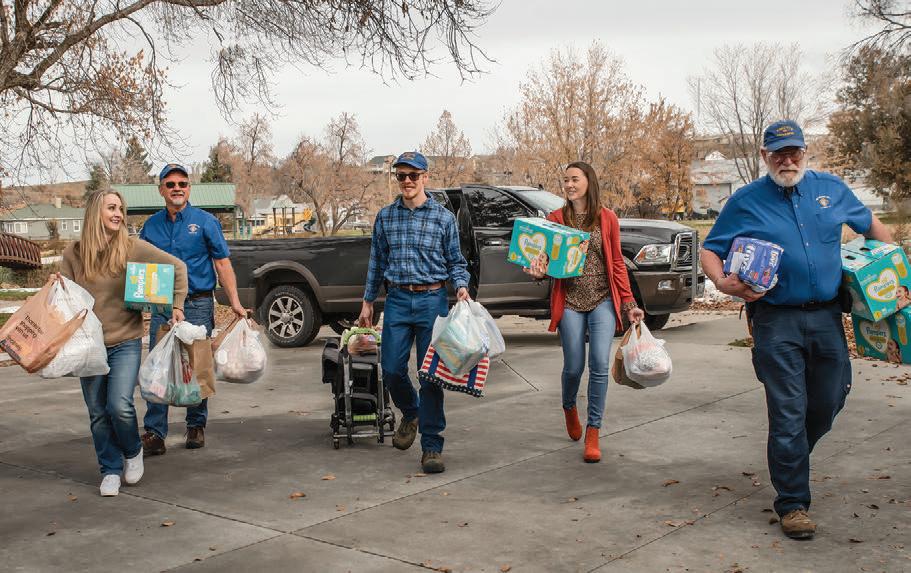
Members of Phil Sheridan Council 2104 in Sheridan, Wyo., and sta from the Legacy Pregnancy Center unload a truckful of diapers and other baby supplies that the Knights collected from parishioners of Holy Name Catholic Church. The council is a frequent supporter of the center, donating more than $5,200 in cash and supplies over the past year, with an additional donation of $400 through the ASAP (Aid and Support After Pregnancy) program.
Knights of Columbus in Virginia recently marked a milestone in their support for Special Olympics: Since 2013, Knights have raised more than $1 million for Special Olympics Virginia by participating in the organization’s annual Polar Plunge events. e funds raised by the Knights each year are earmarked to cover entry fees, accommodations and other costs associated with Special Olympic Virginia’s fall championships.
Archbishop omas J. Walsh Council 3550 in Ridge eld, N.J., donated $25,000 — interest from funds the council invested a er selling its home corporation building — to Several Sources Shelters, an organization that serves mothers and babies in need. An equal donation from the New Jersey State Council brought the amount to $50,000, which the Supreme Council matched through the Ultrasound Initiative. Several Sources will use nearly $60,000 of the funds to purchase
a mobile ultrasound unit, and the rest will go toward ultrasound machines for its Our Gi of Hope Sonogram Center.
When a pro-life demonstration at the Washington State Capitol in Olympia was cancelled a few days before it was scheduled to take place, Puyallup (Wash.) Valley-All Saints Council 1629 worked quickly to organize a pro-life rosary at All Saints Parish, which was a ended by several dozen parishioners.
For 13 years, George F. Monaghan Council 2690 in Livonia, Mich., has sponsored blood drives every two months. e council’s e orts have resulted in more than 2,170 units of blood being donated, including 75 units at its most recent drive.
See more at www.kofc.org/knightsinaction
Please submit your council activities to knightsinaction@kofc.org
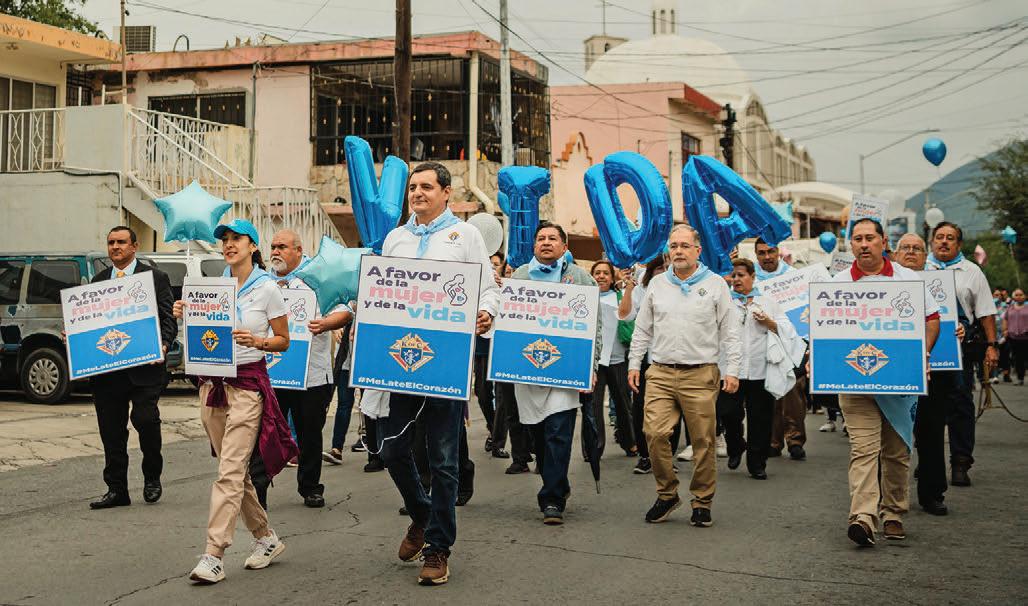
Knights from several local councils and their family members, joined by o cers from the Mexico Northeast State Council, carry signs reading “Me Late El Corazón,” or “My Heart Beats” during a march in support of women and life in Monterrey last fall.
Ontario State Deputy Bruce Poulin
presents a rosary to Army Capt. Richard Bernier, chaplain to the Royal Highland Regiment of Canada, also known as the Black Watch. The Ontario State Council donated about 30 rosaries — replicas of a rosary issued to soldiers in World War I — to Capt. Bernier for distribution to service members.
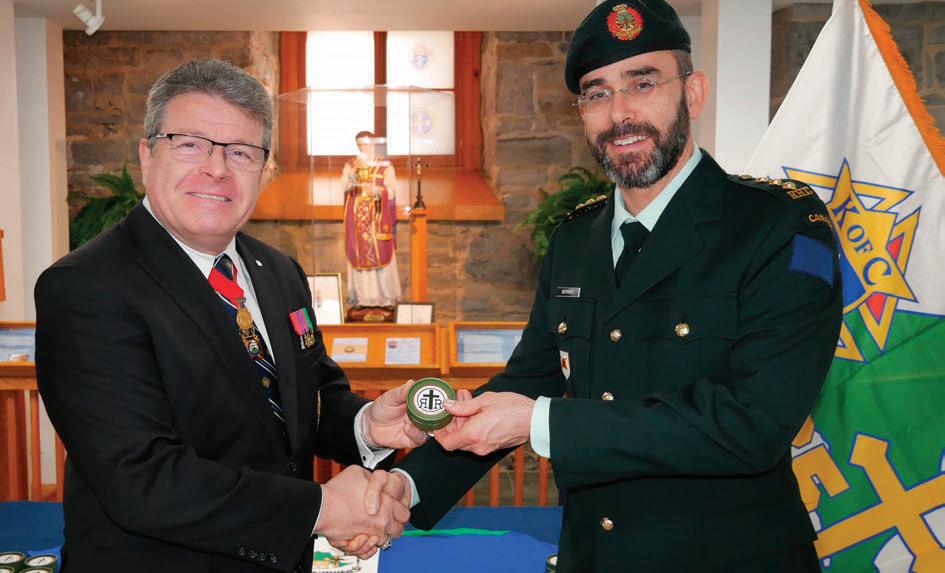
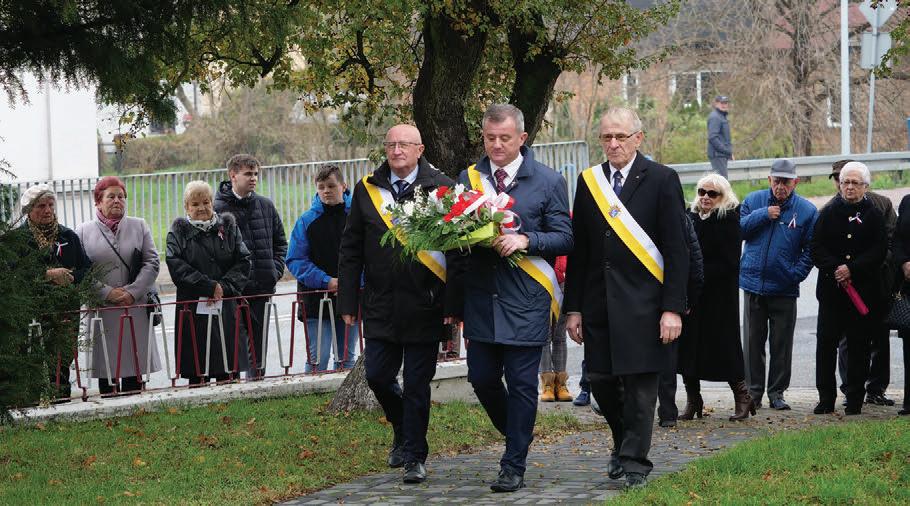
Members of St. John Paul II Council 17645 in Szczekociny carry flowers to be placed on the town’s Tomb of the Unknown Soldier during a ceremony on National Independence Day. The council also provided an honor guard for a special Mass preceding the ceremony at St. Bartholomew the Apostle Parish.

Residents of Avdiivka in eastern Ukraine hold aid packages delivered to the town Jan. 7 by members of Poltova Council 16649. The city in Ukraine's Donetsk region has been the site of fierce fighting since the fall; it fell to Russian troops in February.

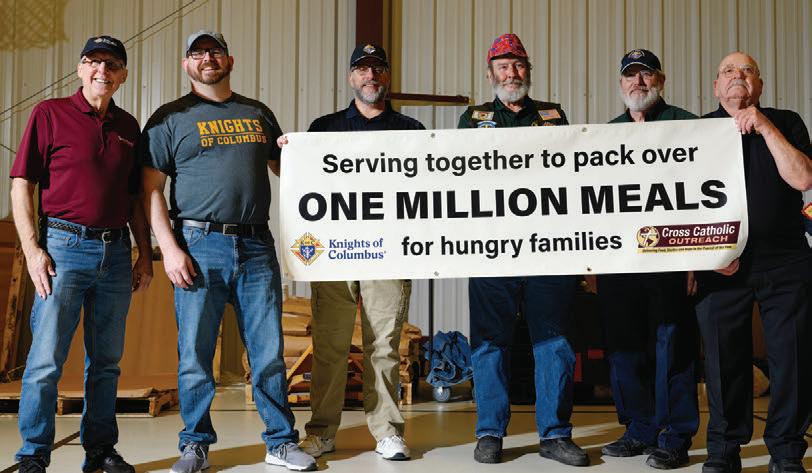
At a meal-packing event in Morgantown, W.Va., K of C leaders celebrate the more than 1 million meals Knights have prepared for families in need in partnership with Cross Catholic Outreach. From left: Terry Waters, manager of special initiatives at Cross Catholic Outreach and past grand knight of Our Lady of Guadalupe Council 12127 in Montgomery Village, Md.; Past State Deputy Scott Nale of West Virginia; State Deputy Michael Kish of Pennsylvania; State Deputy Michael Stanger of West Virginia; State Deputy Christopher Powers of Maryland; and Ned Sawyers of Preston County Council 9578 in Kingwood, W.Va.

Above: Knights from Immaculate Conception Gensanville Council 14286 in General Santos City, Mindanao, distribute clothing, food and toys donated by parishioners of Immaculate Conception Chapel to children in the Bula neighborhood. Council members also prepared and served a meal to the children and their families.
Left: Knights from Santo Domingo de Guzmán Council 14383 in Yauco and other parishioners prepare to begin the annual walking pilgrimage hosted by the council. The theme of the pilgrimage was “Walking with Jesus Through Mary.” Carrying the banner are Past State Deputy Miguel Vidal-Lugo (left) and General Agent Héctor Lebrón-Sanabria.






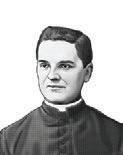
OFFICIAL APRIL 1, 2024:
To owners of Knights of Columbus insurance policies and persons responsible for payment of premiums on such policies: Notice is hereby given that in accordance with the provisions of Section 84 of the Laws of the Order, payment of insurance premiums due on a monthly basis to the Knights of Columbus by check made payable to Knights of Columbus and mailed to same at PO Box 1492, NEW HAVEN, CT 06506-1492, before the expiration of the grace period set forth in the policy. In Canada: Knights of Columbus, Place d’Armes Station, P.O. Box 220, Montreal, QC H2Y 3G7
ALL MANUSCRIPTS, PHOTOS, ARTWORK, EDITORIAL MATTER, AND ADVERTISING INQUIRIES SHOULD BE MAILED TO: COLUMBIA, PO BOX 1670, NEW HAVEN, CT 06507-9982. REJECTED
MATERIAL WILL BE RETURNED IF ACCOMPANIED BY A SELF-ADDRESSED ENVELOPE AND RETURN POSTAGE. PURCHASED MATERIAL WILL NOT BE RETURNED. OPINIONS BY WRITERS ARE THEIR OWN AND DO NOT NECESSARILY REPRESENT THE VIEWS OF THE KNIGHTS OF COLUMBUS.
SUBSCRIPTION RATES IN THE U.S.: 1 YEAR, $6; 2 YEARS, $11; 3 YEARS, $15. FOR OTHER COUNTRIES ADD $2 PER YEAR.
EXCEPT FOR CANADIAN SUBSCRIPTIONS, PAYMENT IN U.S. CURRENCY ONLY. SEND ORDERS AND CHECKS TO: ACCOUNTING DEPARTMENT, PO BOX 1670, NEW HAVEN, CT 06507-9982.
COLUMBIA (ISSN 0010-1869/USPS #123-740) IS PUBLISHED 10 TIMES A YEAR BY THE KNIGHTS OF COLUMBUS, 1 COLUMBUS PLAZA, NEW HAVEN, CT 06510-3326. PHONE: 203-752-4000,

Every day, Knights all over the world are given opportunities to make a di erence — whether through community service, raising money or prayer. We celebrate each and every Knight for his strength, his compassion and his dedication to building a be er world.
Supreme Director Rene Trevino, immediate past state deputy of California, greets a girl after she receives a new wheelchair at CRIT Baja California, a children’s rehabilitation center in Tijuana, Mexico. California State Council leaders recently distributed 60 wheelchairs in Mexico, just a few of the nearly 1,200 wheelchairs the jurisdiction has funded through the American Wheelchair Mission so far this fraternal year.

‘I desired to be always with God.’
Growing up in a Catholic homeschooling family, I received the seed of a religious vocation early. My parents’ e orts to a end daily Mass, in particular, taught me to cherish the Lord’s real presence in the Eucharist. A er Mass, I sometimes wondered how we could leave the Lord in the empty church. Shouldn’t some of us always be with him? Did he want me to? How would I? ese questions persisted during my studies at omas Aquinas College, where I learned to appreciate that a life dedicated to contemplating the truth, especially divine truth, is intrinsically worthwhile.
Further studies at the International eological Institute in Austria were rewarding, but ultimately forced me to a decision: Looking up from thesis research, I realized, “Here I am, thinking about, talking about, writing about God all day — and still it is not enough! I want to be thinking to God all day!” is revelation led me to knock at the door of the Benedictines of Mary, a contemplative community that has ful lled my childhood desire to be always with God.
Sister Mary Josefa of the Eucharist, OSB Benedictines of Mary, Queen of Apostles Ava, Missouri